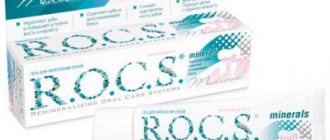Contact Dr.Rudomin dentistry in Moscow for artistic restoration of your front teeth. Our specialists will eliminate any dental defects using modern methods, using professional equipment and materials.
We offer several options for aesthetic dental restoration, which differ in indications, features and cost. During the consultation, the doctor, based on the condition of the patient’s teeth and his wishes, will suggest the most suitable method for restoring the beauty of a smile.
Dentists on Rimskaya
Gneusheva Elena Viktorovna
Dentist-orthodontist, pediatric orthodontist
Experience: 20 years
★ For more than 13 years she worked at the Moscow State Medical University at the Department of Orthodontics and Children's Prosthetics, Ph.D.
Gorokhova Inga Vitalievna
Dentist-therapist
Experience: 14 years of total experience
★ Expertise in restorative dentistry to make your teeth shine
Konstantinov Oleg Nikolaevich
Dental surgeon
Experience: 25 years
★ Virtuoso of painless treatment. Patients fall asleep in the doctor's chair
Nikolaychuk Anna Vladimirovna
Chief physician, dentist-therapist
Experience: 13 years
★ Chief specialist in the treatment of toothache. Masterfully deals with problems quickly and permanently
Frolova Alexandra Ivanovna
Dentist-therapist
Experience: 25 years
★ A brilliant specialist with many years of experience as a manager in public dentistry
Causes of tooth enamel destruction
Damaged tooth enamel can even lead to tooth decay because it does not regenerate. The causes of destruction can be completely different, but they can be combined into several groups, because of which patients are increasingly turning to the clinic.
- Bad habits and lack of proper nutrition. It has long been proven that cigarettes, alcoholic drinks and foods high in sugar have a detrimental effect not only on tooth enamel, but also on the entire body as a whole. In the absence of a balanced diet, disruption of the gastrointestinal tract also occurs, leading to a failure of the acid-base balance. The stomach acid that is released can destroy tooth enamel.
- Sugary carbonated water and excessive consumption of citrus fruits.
- Frequent temperature changes when consuming food and drinks.
- Mechanical damage to the oral cavity, which also includes malocclusion, grinding of teeth, and incorrect treatment process.
- Genetic predisposition.
- Metabolic disorder.
- Age-related changes that contribute to an increase in the distance between teeth.
- Bruxism.
- Childbearing and lactation period.
Specialists working in dentistry will help you find out the exact cause of tooth enamel destruction. The earlier the treatment, the greater the likelihood that it will be possible to avoid the development of severe consequences for the oral cavity, teeth and gums.
Aesthetic restoration
It is also artistic, cosmetic and cosmetological restoration. You can find different names for it on the Internet. The objects for aesthetic restoration are usually the teeth included in the smile zone. Most often these are canines and incisors, less often - lateral units.
Two methods are used for restoration:
- Direct – restoration of a problematic tooth directly in the patient’s mouth. Using photopolymers, the dentist-therapist gives it the required shape in one procedure. The method is suitable for eliminating minor visual defects. It is also called composite restoration.
- Indirect - the use of special microprostheses. They are made from the patient's impressions. The indirect restoration procedure requires more time and several visits to the clinic. Restoration with microprostheses is used for significant defects.
For the indirect method, inlays and veneers are made. Inlays are large fillings that restore the shape of chewing units. They are made from an impression of the tooth, so they fit tightly to its tissues. The tight fit of the inlay reduces the likelihood of developing secondary caries. It is difficult to achieve such an effect with a conventional filling. Dental inlays are much stronger than regular fillings. They restore not only the aesthetics, but also the functionality of the chewing units.
Therapeutic and dental treatment in the clinic
In most cases, home methods for restoring the color of tooth enamel give only a small effect, which lasts only for a while. To get maximum results, it is recommended to consult a doctor. How much does the procedure for restoring tooth enamel cost? The price varies depending on the clinic, the range of necessary measures, and the territorial location (the cost in Moscow and Tambov will vary significantly).
How can the dental clinic help?
- Fluoride varnish. It is prescribed if there is slight sensitivity of the crowns, as well as as preventive measures in childhood and adolescence. In comparison with other ways to protect tooth enamel, this remedy is considered the most inexpensive, but provides significant strengthening of teeth. The essence of the technique is that the dentist applies a protective agent to the crowns, where a protective layer is subsequently formed, due to which fluoride is released into the tissue.
- Remineralization. The key difference from fluoride varnish is that when it is used, the enamel is saturated with a whole complex, which, in addition to fluorine, also includes calcium ions. Thanks to additional preparations, tooth enamel is quickly restored and thickened.
- Deep fluoridation. This technique is based on covering all teeth with varnish, which fills even small cracks in the enamel. This technique allows for quick recovery and reduces the risk of caries formation by 2 times. In addition, the condition of the teeth improves, soft tissue restoration is noted, and hardness increases.
- Filling. You should not think that this is a standard procedure, because during restoration this happens in several stages. The dentist independently determines how many layers will need to be applied to the tooth in order to cover all the damage and cracks present on the surface.
Restoring the enamel layer of a tooth is affordable for every person, given that modern dentistry provides a wider range of available services.
Fluoridation of teeth
Fluorine increases the protection of enamel hydroxyapatites, forming acid-resistant hydroxyfluorapatite complexes with them. The procedure involves applying fluoride-containing substances to the surface of the tooth. It is most effective during the period of enamel maturation - in the first months after eruption. If necessary, the procedure is carried out in adulthood.
Important! It is not recommended to perform fluoridation on your own, at home! Uncontrolled use of fluoride-containing drugs can provoke various complications from organs and their systems.
Professional fluoridation is performed a limited number of times, so in order to naturally replenish the lack of fluoride, it is necessary to ensure the supply of this mineral with food. Its accessible and safe forms for the body are found in foods such as mineral water, walnuts, sea fish, spinach, and onions.
Attention! Excess fluoride can cause a reverse reaction on the part of the enamel - fluorosis. It is characterized by the appearance of specific fluorescent spots.
Modern methods of treatment
The technological advancement of processes does not stop, so modern medicine, improving, is ready to offer innovative methods that can solve the problems of pathological abrasion of tooth enamel, eliminate cracks in the shortest possible time and quickly level the surface of the crown.
These include, for example, enamel implantation, which can restore even severely damaged teeth. A qualified clinic specialist creates a material that, in its external characteristics, is indistinguishable from natural enamel. With its help, an organic replacement of the destroyed part of the tooth occurs.
Using this method, you can cosmetically correct a defective bite. If a person takes proper care of their oral cavity, such an implant will last for decades.
Dental onlays deserve special attention, allowing the client to achieve the effect of the famous Hollywood smile. They are divided into two types:
- Lumineers
- Veneers
The key difference between them is the fact that when placing lumineers, teeth are not ground down, and in terms of external characteristics they are much thinner. Doctors recommend resorting to this technique if all other methods have already been tried.
It is worth noting that, despite the fact that strong and durable porcelain is used in the manufacture of onlays, even with careful care, the products become unusable over time. The average length of their service is approximately 15 years.
Among the advantages, of course, stands out the ability to completely cover all existing defects of tooth enamel, hide or clearly reduce the dental space, as well as mask the incorrect position of the tooth in the socket.
Types of damage and their symptoms
Damage to enamel is classified as non-carious diseases. They develop gradually and may have a long latent period. Main features:
- change in tooth color/shade, appearance of spots or stripes of a different color;
- presence of cracks, chips;
- increased sensitivity of teeth with the manifestation of a painful reaction to sweet, sour, hot, cold;
- change in shape and structure in the form of erosions, bumps, pathological abrasion.
In specific cases, the set of signs depends on the causes of enamel destruction and concomitant diseases. Basic examples:
- thin “wrinkled” surface of the teeth – during amelogenesis;
- thinned dark enamel of a brown tint - with congenital Stanton-Capdepont syndrome (the color of the enamel is determined by blood decay products in the dentinal tubules);
- amber teeth with very fragile enamel – with pathological dentinogenesis;
- matte surface and wedge-shaped defect – with fluoride deficiency against the background of increased acidity of saliva;
- pathological wear of teeth with shortening of their crown part - with a general mineral deficiency of calcium, phosphorus, silicon, zinc, as well as hypovitaminosis of vitamins C, D, A, group B;
- necrosis of dental tissues – with severe hormonal imbalance, as well as long-term treatment with antibiotics.
Pathologies can be congenital or acquired. A striking example of a congenital disorder of tissue mineralization are various types of dysplasia, including Stanton-Capdepont disease, amelogenesis and dentinogenesis. The majority of deficiency and dystrophic pathologies are acquired.
Treatment and restoration of enamel at home
If there is minor damage to the teeth and approval after consultation with a specialist at a dental clinic, you can resort to traditional methods. However, when using them, you should understand that the enamel is easily damaged and cannot be restored without professional help. When starting treatment with traditional methods, it is important to understand that there will be no quick results, this is a long process.
What recipes will help in the process of restoring tooth enamel?
- Baking soda. It can be used no more than once a week, because the substance has too high a degree of purification.
- White lemon pulp. This method is considered the most productive, but it must be used for a maximum of 7 days. The soft skin of the lemon will need to be used to wipe the enamel of the teeth.
- An ideal companion to help with such a sensitive issue is tea tree oil. To achieve maximum effect, you only need a couple of drops diluted in a glass of water. The resulting liquid should be rinsed in the mouth. In addition to strengthening and restoring enamel, the oil helps get rid of pathogenic bacteria and bad breath. If you regularly use tea tree oil, your teeth will be protected from periodontitis and caries.
- Fruits. As surprising as it may be, strawberries also have a restorative function. You will need to mash the berries well, apply to your teeth and hold for several minutes. After the procedure, you will definitely need to thoroughly brush your teeth.
- Activated carbon. With its help, you can whiten your teeth and remove unwanted plaque. To create an ointment, you will need a couple of charcoal tablets, which are then rubbed into the enamel. After 5 minutes, it is important to rinse your mouth thoroughly. You should not conduct such experiments more than twice a week.
- Sea salt. In this case, additional ingredients will be required, in the form of 4 tablespoons of salt and half a glass of water. You need to rinse your mouth with the solution for a month. You can also rub dry sea salt with a brush, but before doing this, it is recommended to grind it.
Special gels and toothpastes deserve special attention. You should not rely on advertising that promotes the “best” pasta. In fact, each of them is focused on solving a specific problem. However, when purchasing any of them, you should definitely consult with your doctor.
Advantages and disadvantages of veneer restoration and composite restoration
The restoration method is chosen by the dentist based on the clinical situation and the wishes of the patient. To understand the advantages and disadvantages of these methods, let’s compare them:
- Recovery time. Direct restoration takes place in one session and requires about 20 minutes per tooth, indirect - at least 2 sessions, an hour each.
- Tooth treatment. For direct restoration it is ground slightly, for indirect restoration it is ground to a greater extent.
- Wear resistance. Composite materials wear away over time, but porcelain veneers do not. However, chips may appear on the ceramics if the microprosthesis was not fitted correctly or you tried to chew hard objects with it.
- Life time. Areas restored with composite materials will last 2-4 years, and ceramic veneers - up to 10 years.
- Preservation of the original color. Composite material becomes stained over time from food dyes; ceramics are more resistant to them.
- Price. Composite restoration is cheaper because it takes less time and does not require additional equipment. The cost of restoration with veneers is much higher, due to the high cost of the microprostheses themselves and the difficulties in installing them.
Prevention
When trying to keep your teeth enamel in order, experts also advise reviewing your diet and not forgetting about preventive measures.
By introducing certain products into your regular menu on an ongoing basis, you can strengthen both your teeth and gums.
- Milk and dairy products. They help replenish the body’s small amounts of calcium, phosphorus, protein and vitamins such as A, D, C, B.
- Fish and seafood that contain phosphorus, iodine, fluorine and calcium.
- Coconut oil. Its action will help get rid of fungal infection and allow calcium and magnesium to be properly absorbed.
- Greens, in particular broccoli, which contain bactericides that help protect against periodontal disease and caries.
Among other recommendations, it is worth noting that a good prevention of damage to tooth enamel is regular gum massage, which increases blood flow. To achieve maximum effect, you will need to perform massage actions 3-4 times a day, after washing your hands well. To ensure that the massage is not in vain, it is advisable to reduce the consumption of too hard foods, because this can cause mechanical damage.
In addition to including foods in your daily diet, it is also worth excluding something. First of all, these should be carbonated drinks with a large amount of caffeine. Also, do not abuse alcohol and reduce, or even give up, cigarettes. It is necessary to visit the dentist twice a year; consultation and prevention will help protect teeth and enamel from destruction.
The difference between restoration and filling
During the restoration process, the dentist-therapist recreates the tissues of the problematic tooth. In this way, it is similar to the filling process, in which the affected tissue is removed and the remaining cavity is sealed with artificial material (filling and composite).
However, both of these procedures are carried out for different purposes:
- filling is prescribed for therapeutic treatment to stop the carious process and save the tooth from further destruction,
- restoration is carried out for aesthetic purposes to correct or hide external defects.
As a rule, filling is carried out on teeth affected by caries, in rare cases - on healthy ones (for example, when a healthy tooth will support a bridge: it is first depulped and filled). The objects for restoration are partially destroyed teeth, as well as healthy units that have aesthetic defects.
Composite filling materials and microprostheses are used for restoration, and fillings are used for filling. During the restoration process, the dentist-therapist recreates areas that do not differ in shade and transparency from the natural tissues of the problem tooth. You won't be able to achieve this effect with a filling.
On various dental portals, the dental restoration service is called aesthetic or artistic restoration.








